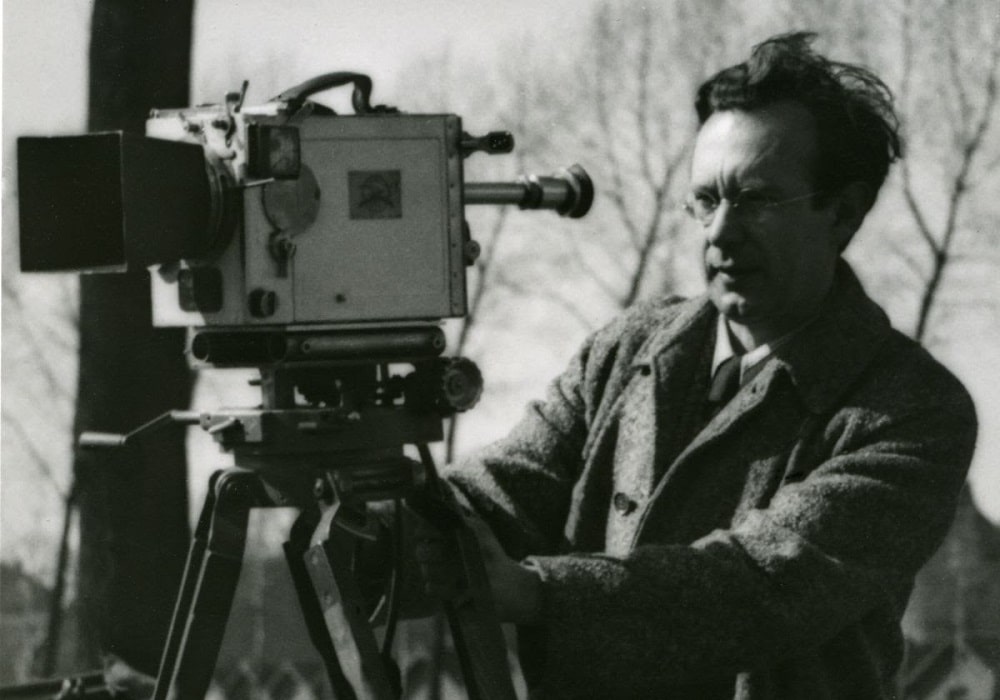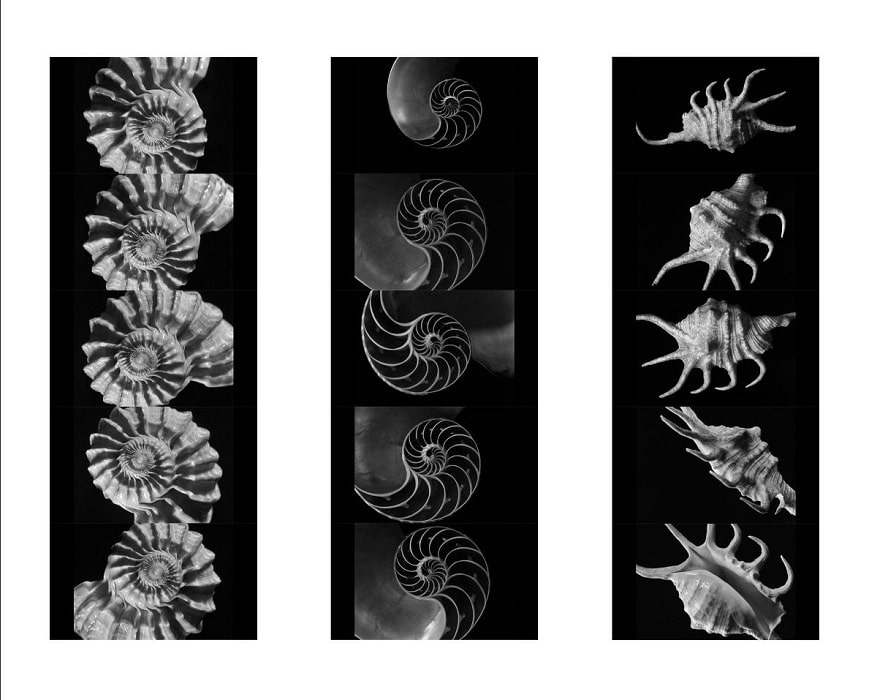On the occasion of its 20th birthday on 18 November 2022, the Alfred Ehrhardt Foundation will present a film gala with live music as well as three anniversary programmes at Babylon on further dates in November and December with newly digitised and colour-restored short films by Alfred Ehrhardt.
Image caption: Alfred Ehrhardt aus dem Film “Spiel der Spiralen. Von der Architektur der Meeresschnecken”, 1951, 35mm, s/w, Ton, 16 min. © Alfred Ehrhardt Stiftung
For Ehrhardt, a nature filmmaker trained at the Bauhaus by Albers, Kandinsky and Schlemmer and one of the most important photographers of the New Objectivity, film is primarily visual art. Optical narration with modern, electronic musical compositions characterises his films. His musical training and the artistic influence of the Bauhaus were reflected in his preoccupation with abstraction, archaism, archetypal form, surface structure, material behaviour, ornament, rhythm, polyphony and seriality.
Film Gala for the 20th Birthday of the Alfred Ehrhardt Foundation
The Munich musician duo Nicole Heartseeker (organ, harpsichord, piano) and Mulo Francel (saxophone, clarinet) set three films to music live on the cinema orchestra organ, the only silent film organ in Germany still in its original location: Spiel der Spiralen (1951, 15′), Tanz der Muscheln (1959, short version 10′), Korallen -Skulpturen der Meere (1964, 12′). Their original settings by Bach, Keller/ Aign and Sala can be heard in the anniversary programmes 1-111. These are followed by the colour films on documenta II Art of Our Time I: Sculpture 1945-1959 (1959, 14′) and on Iceland Glaciers and their Streams (1962, 10′).
Babylon, Room 1, Rosa-Luxemburg-Str. 30, 10178 Berlin
Friday, 18 November 2022, 8.00 p.m.
Introduction: Jens Ehrhardt, Christiane Stahl, Thomas Bakels, Thomas Tode
Admission to the film gala followed by a reception is free.
Tickets can be reserved online at babylonberlin.de .
Curated by Hamburg film historian Thomas Tode, the programmes include 12 award-winning sound films, restored with funding from the German Federal Film Board in 4K quality as part of the digitisation of Germany’s film heritage. The events are the prelude to a nationwide film retrospective that will start in Berlin at the Babylon, continue at the Metropolis Kino Hamburg from 10 to 31 January 2023 and run in other art house cinemas until the end of 2023.
I Bauhaus views: life processes made visible through the media
Ehrhardt’s cultural and documentary films are in the Bauhaus tradition of observing nature. Like abstract paintings, he shows the structures of spinning snail shells and shells drawn by coloured growth features. The Bauhaus was concerned with life processes made visible through the media! These are only revealed by the film and photo camera. Spiel der Spiralen (D 1951, 15′) glorifies the winding architectures and reliefed natural forms of snail shells, also with the help of the chiselled, accurate music of Johann Sebastian Bach. In Tanz der Muscheln (D 1956, 16′), the patterned marvels of nature spin to the modern electronic sounds of Wilhelm Keller and Bernhard Aign. The bizarre underwater world in Corals, Sculptures of the Seas (D 1964, 12′) is echoed in Oskar Sala’s electroacoustic music produced with the trautonium. Ehrhardt shot his very first film, Urkräfte am Werk (D 1937 /39, 15′), which today only exists in fragments, in the mudflats off Cuxhaven, with wind and waves as pictorial elements, sand and water as the main characters. 13 years later, he again traced the mudflat structures and sand formations, rushing ahead on a horse-drawn carriage to the island of Neuwerk: Inselfahrt (D 1950, 12′).
Babylon, Rosa-Luxemburg-Str. 30, 10178 Berlin
Thursday, 24 November 2022, 8.00 p.m.
Introduction: Thomas Tode#
II. Views on Art: Classics & Modernism
Films about art are always films about perception. Kunst unserer Zeit I: Skulptur (D 1959, 14′) shows modern sculptures from the Kassel documenta II, set up in the green parklands of the Aue and in front of the walls of the Orangerie, which was destroyed in the war, viewed by visitors. The camera knows how to unfold plasticity, driving around the sculptures in short travels (Henty Moore), turning them on plates (Alberto Giacometti) and letting kinetic art float in black empty space (Alexander Calder). Art of Our Time II: Painting (D 1960, 14′) shows the modern painting of Documenta II as a raucous colour festival. The commentary explains abstract art to Germans who were cut off from international art developments during the Nazi era. For example, he recalls war and apocalyptic horror in Pablo Picasso and presents contemporary works by Max Ernst, Hans Hartung, Wassily Kandinsky, Paul Klee, Wilfredo Lam and Jackson Pollock in a crash course – always accompanied by the electronic futuristic sounds of Oskar Sala. Only ten years earlier, Ehrhardt had filmed the sculptures of the Nazi-demonised artist Ernst Barlach only in an empty black room and set them to classical music: Ernst Barlach I – Der Kämpfer (D 1948, 15′) with Peter Tchaikovsky, and Ernst Barlach II – Der Überwinder (D 1948, 15′) with Anton Bruckner. In a space of absolute character, they appear as eternal and timeless works of art, not contaminated by environment (church space) or history (dismantling of the sculptures by the Nazis). The depiction of the Passion story in Ad Dei Honorem (D 1948, 15′) also has an archaic religious effect.
on Hans Brüggemann’s Bordesholm altar in Schleswig Cathedral. The style of these immediate post-war works can probably be read as a document of Ehrhardt’s distance and insecurity: Timeless art had not compromised itself in the war and is the only thing that can still be trusted.
Babylon, Rosa-Luxemburg-Str. 30, 10178 Berlin Thursday, 8 December 2022, 8.00 p.m. Introduction: Thomas Tode

III. Islands Aggregatzustände: Festes, Flüssiges, Gasförmiges
States of aggregation are fundamental manifestations of matter, for example ice (solid water), water (liquid water) and water vapour (gaseous water). Ehrhardt has also portrayed other substances such as lava, ice formations and scree landscapes in their three states of aggregation. With the help of the film, we look back into the earth’s history of our planet. In Vulkanisches Antlitz (1961/62, 11′) glowing lava flows sluggishly down the slope and red glowing magma sprays in high arcs. In Dampfende Erde (D 1961/62, 10′) hot springs and geysers hiss. In Gletscher und ihre Ströme (D 1961/62, 10′) the arctic world of eternal ice covers the glaciated volcanoes. In Boiling Earth (D 1962, 11′), fountains bubble against the strong colour of the sulphur volcanoes. Ice: Greenlandic Sketches (D 1962/63, 12′) explores the island’s ice sheet: Pack ice off the coast, mighty inland ice, the enormous Sehreit glaciers running from the central ice field to the fjords. Metallic, clanging electric sounds by Oskar Sala accompany all these films – quite different from his first Iceland film, Nordische Urwelt (Iceland) (D 1941, 17′), which was made during the Nazi era, and in which bombastic, upbeat, late-Romantic music sounds to thundering waterfalls – in kitschy Nazi style.
Babylon, Rosa-Luxemburg-Str. 30, 10178 Berlin
Thursday, 15 December 2022, 8.00 p.m.
Introduction: Thomas Tode
Short biography of the filmmaker Alfred Ehrhardt by Thomas Tode
For Bauhaus-trained filmmaker Alfred Ehrhardt, an important photographer of the New Objectivity, film is primarily visual art. Ehrhardt (1901-1984) is one of the most important filmmakers and photographers of the Bauhaus tradition, with over 50 films and more than 20 illustrated books on photography. He received numerous national and international awards for his films, including four Federal Film Awards. In 1948, he was even called “the most important German post-war creator of cultural films”; today we would rather speak of an old master of experimental cultural and documentary film. Especially in the films Spiel der Spiralen (Game of Spirals), Tanz der Muscheln (Dance of Shells) and Korallen – Skulpturen der Meere (Corals – Sculptures of the Seas), he took his cue from avant-garde photography and the absolute film of the 192Os – works that are still of challenging modernity today.
Ehrhardt was initially an organ musician, composer, painter and art teacher before shifting his interests to photography and film. Having already worked as an art teacher, he took leave of absence to study at the Dessau Bauhaus in 1928/29, especially with Josef Albers. He also sat in on classes with Wassily Kandinsky and Oskar Schlemmer. In 1930, he was appointed to the Landeskunstschule Hamburg (today: Hochschule für bildende Künste) and taught the first preliminary course in materials science outside the Bauhaus. In 1933, the National Socialists dismissed him because of his closeness to the Bauhaus and his modern attitude to art. He withdrew to the countryside and in 1934 took a job in his first profession as an organist and choirmaster in Cuxhaven. There he first turned to photography and from 1937 to film. His first photo excursions in the Elbe-Weser mudflats fall into this period. Ehrhardt quickly realised that “the camera produced what was forbidden to paint – degenerate – in an innocuous way”. 1937 also saw the publication of Ehrhardt’s first illustrated book, “Das Watt” (The Mudflats), which today is counted among the outstanding pictorial achievements of the avant-garde of the 193Os, for example in Martin Parr’s and Gerry Badger’s standard work” The Photobook. A History” (London 2004, p. 112).
His musical training and the artistic influence of the Bauhaus were clearly reflected in his cinematic work, for example in his preoccupation with abstraction, archaism, archetypal form, surface structure, material behaviour, ornament, rhythm, polyphony and seriality. His romantic-metaphysical view of the world, already hinted at in painting and graphic art, is reflected in film in a meditative contemplation of nature that unfolds over time. In masterful compositions, he captures nature’s “plays of light” with the camera, showing her work as a “master of form” on mudflats and sand structures or in the architectural construction of animal shells. Snails and shells rotate in an abstract black space, exposing their construction secrets, sometimes ‘drawn’ by coloured growth features reminiscent of abstract Kandinsky paintings. It is about life processes made visible through the media, which only the film and photo camera can reveal. Our ‘unarmed’ eye is not capable of recognising them, hence the use of genuinely cinematic techniques such as time-lapse, slow motion, micro and macro shots.
WHEN?
Friday, 18 November 2022, 8 pm
Film Gala for the 20th Birthday of the Alfred Ehrhardt Foundation
Thursday, 24 November 2022, 8 pm
I. Bauhaus views: life processes made visible through the media
Thursday, 24 November 2022, 8 pm
I. Bauhaus views: life processes made visible through the media
Thursday, 08 December 2022, 8 pm
II. Views on Art: Classics & Modernism
Thursday, 15 December 2022, 8 pm
III. Islands Aggregatzustände: Festes, Flüssiges, Gasformiges
WHERE?
Babylon Kino
Rosa-Luxemburg-Str. 30
10178 Berlin






